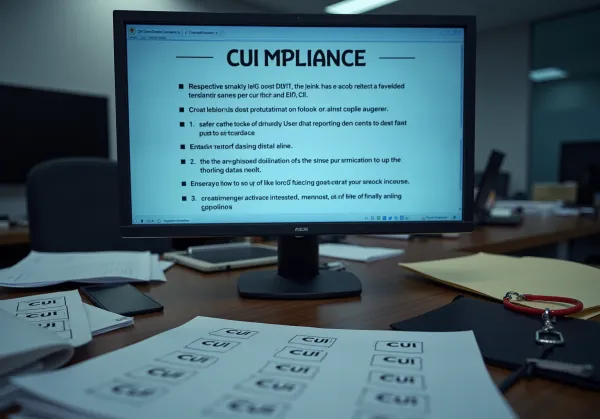10 Key Roles Responsible for Applying CUI Markings and Instructions
Discover the key roles responsible for applying CUI markings and ensuring compliance in your organization.

Overview
The article examines the pivotal roles involved in the application of Controlled Unclassified Information (CUI) markings and instructions within organizations. It asserts that designated employees, organizational leaders, compliance officers, and legal advisors play essential roles in ensuring accurate marking, adherence to regulations, and the protection of sensitive information. This collective effort not only enhances compliance with Department of Defense requirements but also fortifies the organization's overall information security posture. By recognizing and empowering these key personnel, organizations can effectively navigate the complexities of CUI management and safeguard their critical assets.
Introduction
Navigating the intricate landscape of Controlled Unclassified Information (CUI) compliance presents a formidable challenge for organizations, especially as the Department of Defense amplifies its emphasis on cybersecurity standards. This article explores the ten pivotal roles that are essential for the effective application of CUI markings and instructions. Each position plays a crucial role in ensuring regulatory adherence.
How can organizations strategically leverage these roles to bolster their compliance efforts and protect sensitive information from unauthorized access?
CMMC Info Hub: Your Resource for CUI Compliance Guidance
CMMC Info Hub serves as an essential resource for organizations aiming to meet the requirements of the Cybersecurity Maturity Model Certification (CMMC), particularly concerning Controlled Unclassified Information (CUI). This platform provides a , including comprehensive articles, practical guides, and actionable strategies that address the complexities of CUI regulations. Recent updates underscore the critical importance of adhering to CUI regulations, especially as the Department of Defense (DoD) amplifies its focus on cybersecurity standards.
Effective strategies for CUI adherence have emerged from defense organizations that prioritize thorough documentation of CUI data flows and network segmentation. These practices not only simplify regulatory compliance but also mitigate audit complexity and costs. Experts emphasize that robust CUI adherence is not just a regulatory obligation; it is a crucial element for securing defense contracts. As the landscape evolves, organizations must remain vigilant and proactive in their compliance efforts to avoid penalties and maintain eligibility for federal contracts.
By leveraging insights from industry specialists, CMMC Info Hub empowers businesses to navigate the stringent requirements set forth by the DoD, ensuring they are adequately prepared to meet regulatory standards and enhance their competitive edge in the defense sector.
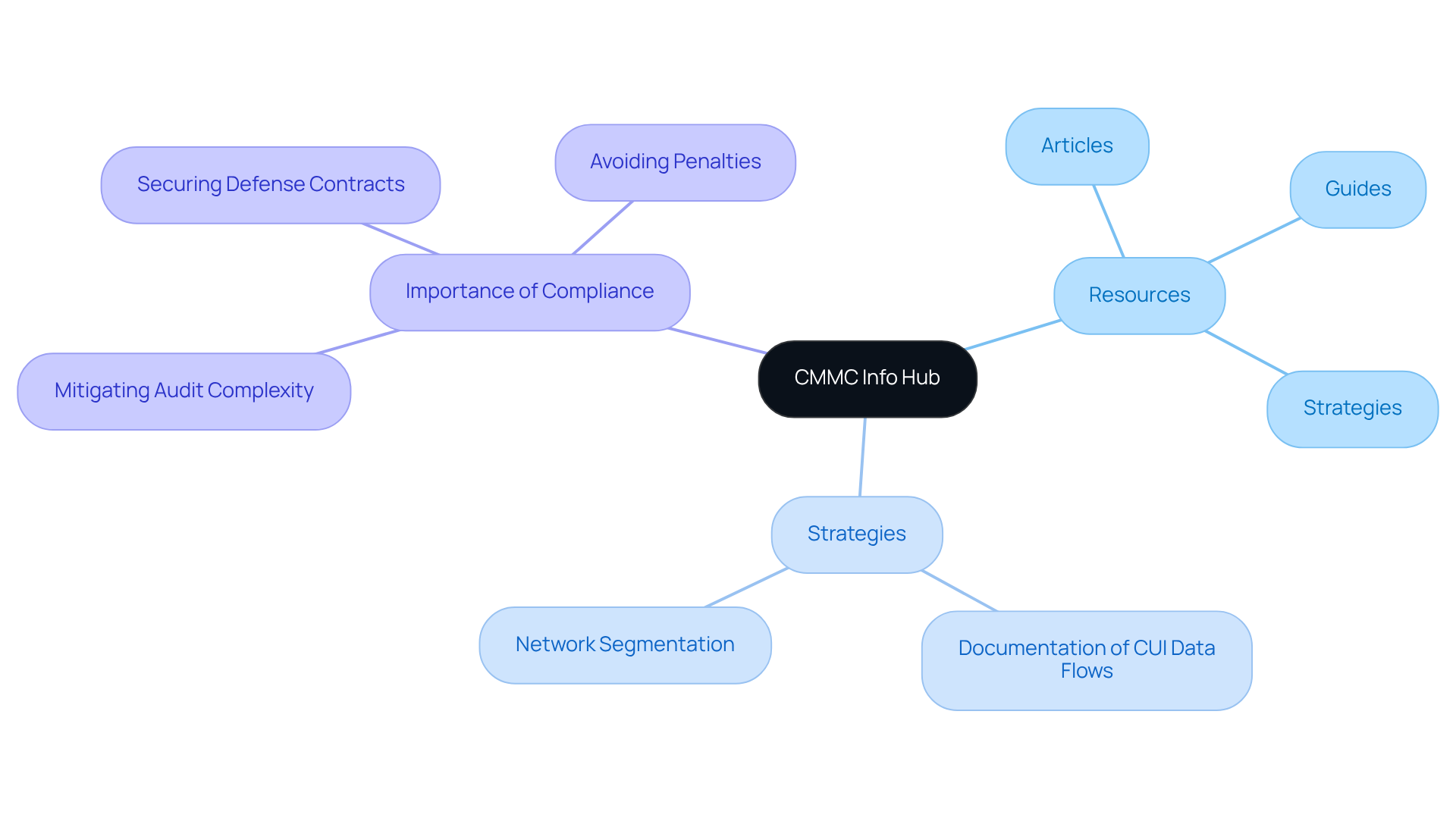
Organizational Leadership: Setting CUI Compliance Policies
Organizational leadership holds a critical responsibility: defining and implementing policies for Controlled Unclassified Information (CUI) adherence. This entails establishing precise guidelines on who is responsible for applying and dissemination instructions in the handling and marking of CUI. Leaders must ensure that these policies not only align with Department of Defense (DoD) requirements but are also communicated effectively throughout the organization. By fostering a culture of compliance, leadership enhances the overall cybersecurity posture and readiness for defense contracts.
How can your organization strengthen its commitment to these essential policies?
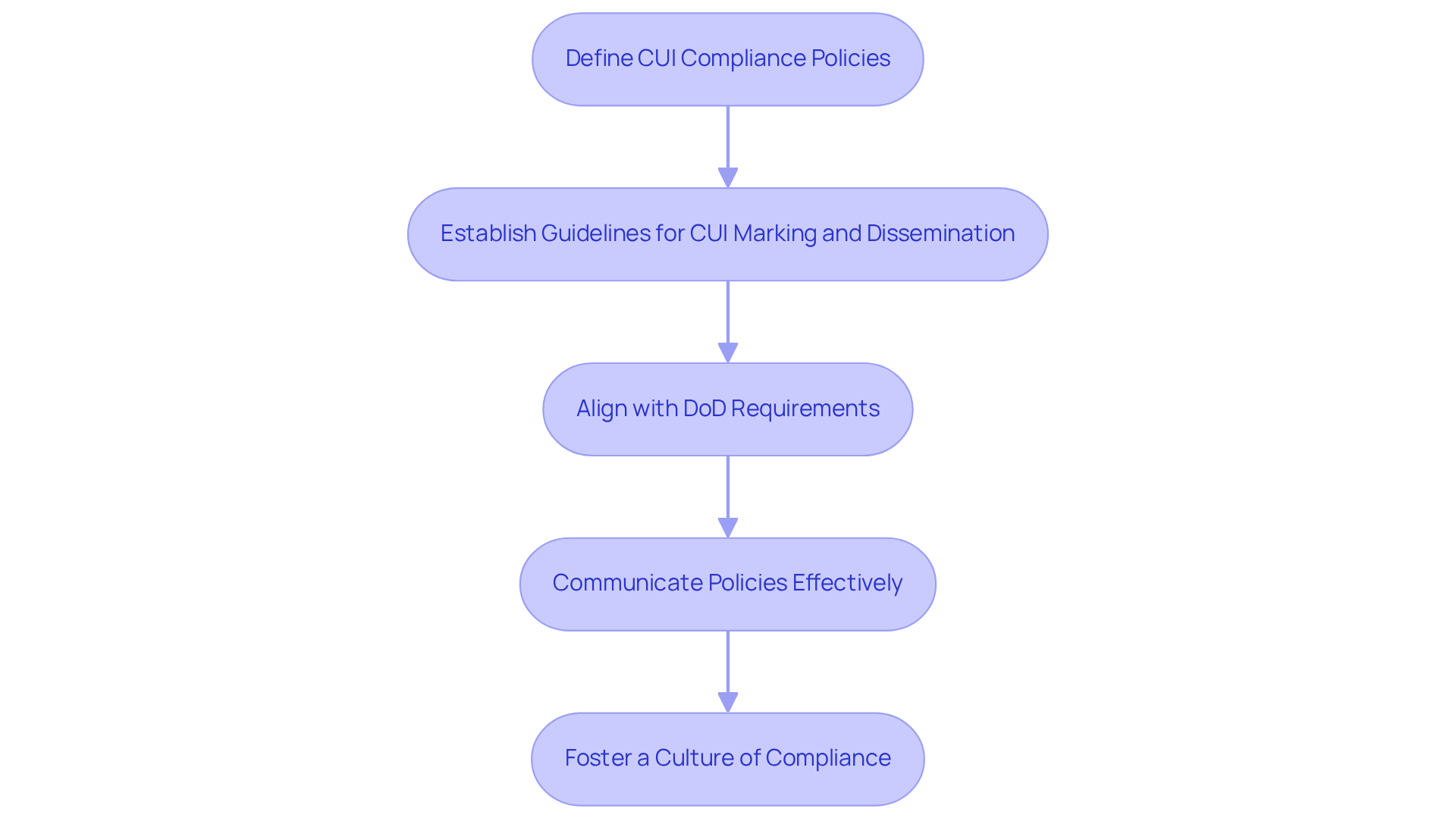
Designated Employees: Implementing CUI Markings
Designated employees, who are responsible for applying CUI markings and dissemination instructions, are pivotal in the effective implementation of Controlled Unclassified Information (CUI) markings on documents and materials. Their preparation is essential for recognizing what qualifies as CUI and understanding who is responsible for applying CUI markings and dissemination instructions in accordance with DoDI 5200.48 guidelines. This responsibility is crucial for and ensuring that sensitive information is managed correctly.
Every document containing CUI must include a CUI header and a designation indicator to facilitate proper recognition of sensitive material. Furthermore, identifying all data flows of CUI within the entity is vital, encompassing communications between systems, personnel, third-party vendors, and customers. Creating data flow diagrams can assist in visualizing these flows and identifying all assets in scope for assessment.
Regular practice meetings not only reinforce the significance of precise marking but also enhance adherence to federal regulations. Statistics reveal that organizations with robust development programs experience a significant decrease in adherence failures and security incidents related to CUI mishandling, including potential contract loss and unauthorized access. Effective training initiatives often incorporate practical exercises and assessments, ensuring employees are well-equipped to manage CUI appropriately, thereby strengthening the overall security posture of defense contractors.
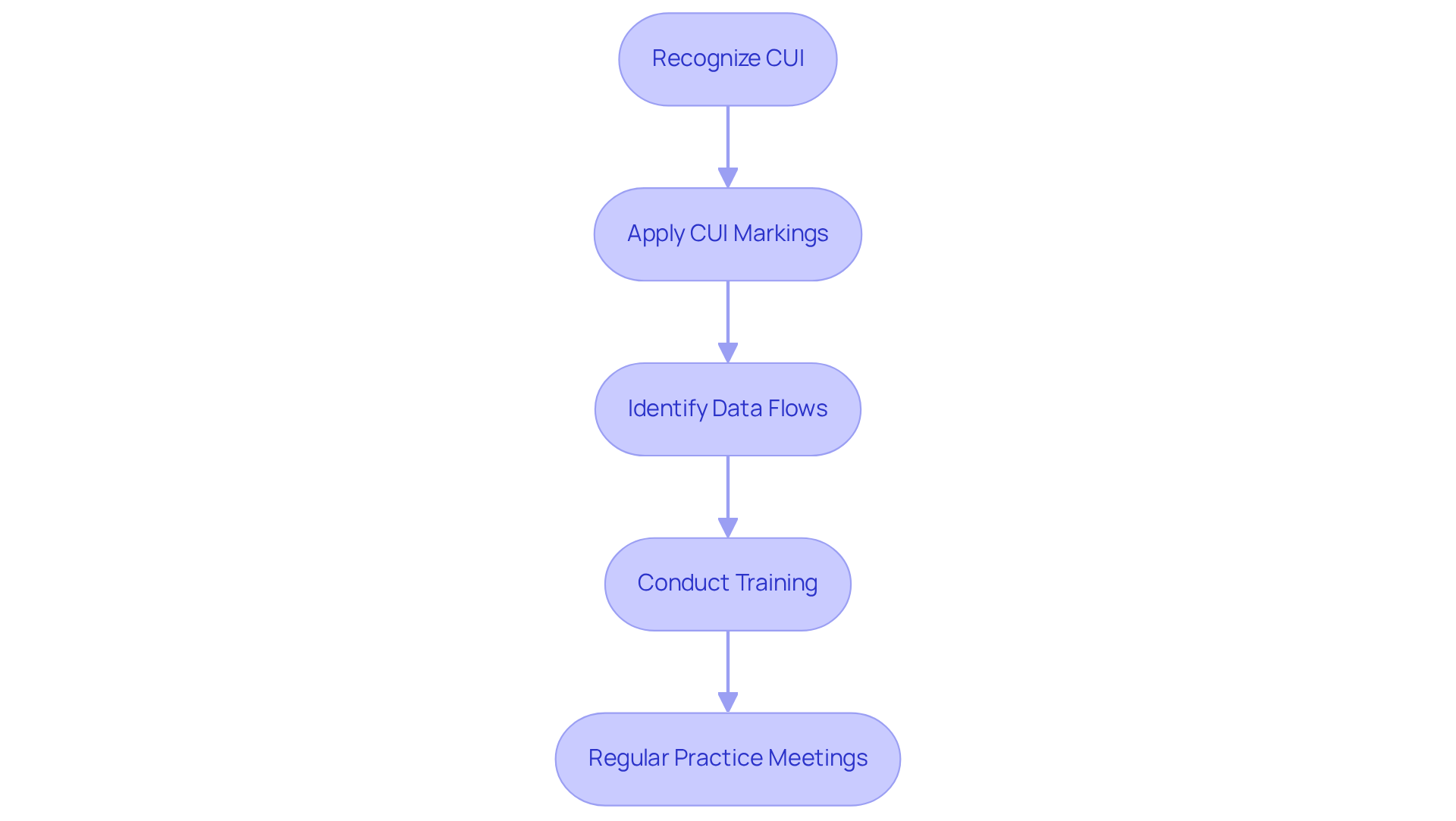
Document Creators: Applying CUI Markings at Creation
Document creators, who are responsible for applying CUI markings and dissemination instructions, play a pivotal role during the document creation process, particularly in relation to FAR 52.204-21, which sets forth essential safeguarding requirements for federal contractors. Their responsibilities encompass the identification of sensitive information and ensuring that it is properly marked by the person who is responsible for applying CUI markings and dissemination instructions according to established guidelines. This proactive approach not only facilitates adherence but also safeguards the integrity of the information. Failure to properly safeguard or loss of controlled unclassified information (CUI) can result in significant adverse effects on organizational operations, including degradation in mission capability and financial loss.
To address these concerns, effective training programs for document creators, such as the DoD Mandatory Controlled Unclassified Information Training, must emphasize the criteria for . It is crucial that document creators understand who is responsible for applying CUI markings and dissemination instructions, as well as the nuances of what constitutes CUI and the correct procedures for marking it. For unclassified documents that contain CUI, it is essential to place 'CUI' at both the top and bottom of each page, along with a CUI designation indicator on the first page.
By prioritizing CUI marking at the creation stage, organizations can significantly enhance their compliance with regulations and protect sensitive data from unauthorized access. This aligns with the requirements outlined in FAR 52.204-21 and reinforces the importance of diligence in safeguarding controlled unclassified information.
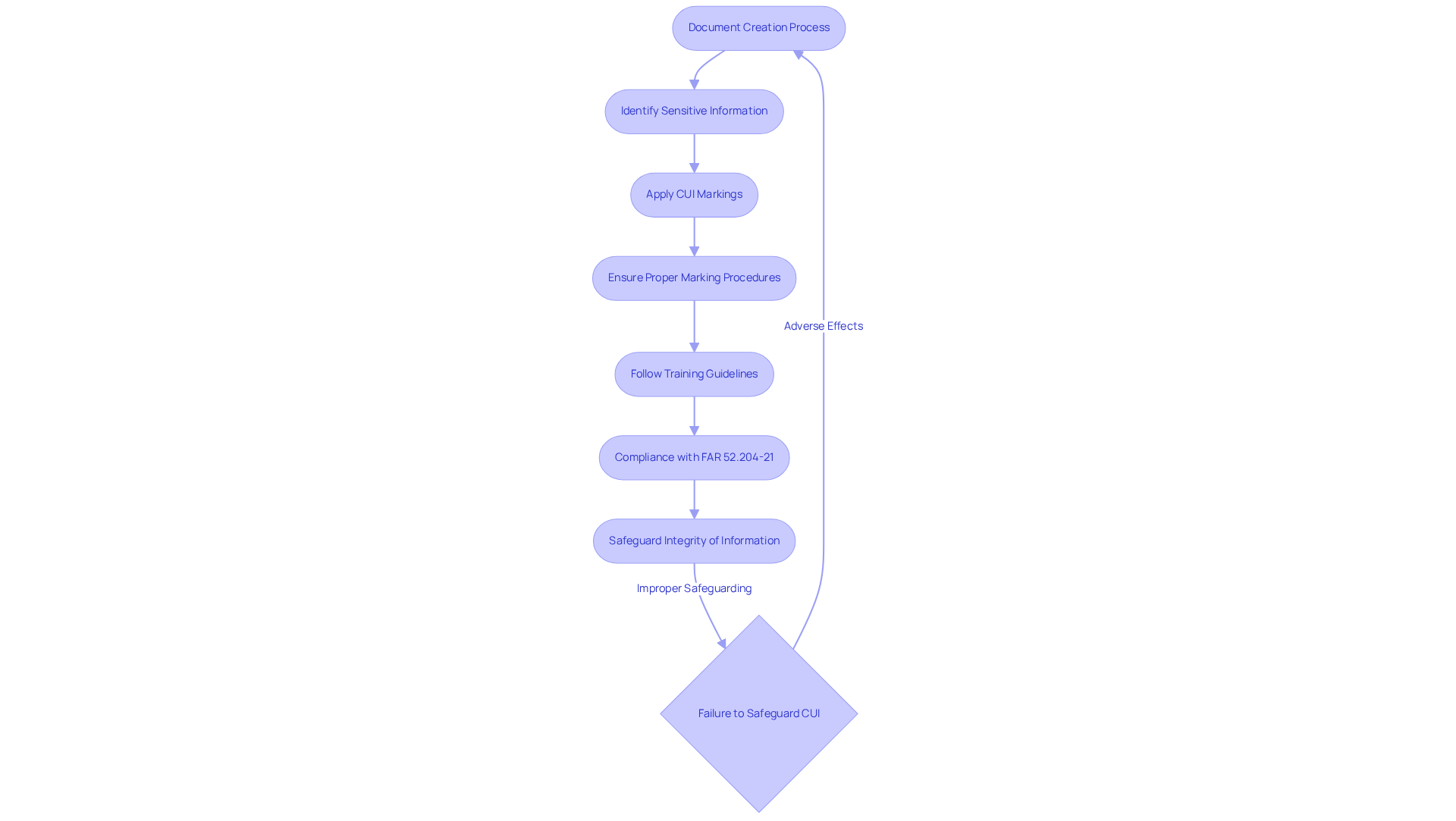
Authorized CAC Holders: Managing CUI Access
Authorized CAC holders, who are responsible for applying CUI markings and dissemination instructions, play a pivotal role in safeguarding Controlled Unclassified Information (CUI) within their organizations, serving as a critical component of the roadmap to achieving CMMC adherence. Their primary responsibility is to ensure that only individuals with the necessary security clearance can access sensitive information. This involves not only granting access but also diligently monitoring access logs to detect any unauthorized attempts to access CUI. Regular audits are crucial for sustaining a secure environment, as they assist in identifying possible vulnerabilities and ensure adherence to Department of Defense regulations.
Implementing robust access control measures is essential for CUI security and aligns with ongoing monitoring practices necessary for CMMC compliance. By establishing clear protocols for who can access what information, organizations can significantly reduce the risk of data breaches. Furthermore, ongoing training for personnel on the importance of CUI protection and the proper handling of sensitive information is vital. This proactive approach promotes a culture of security awareness and adherence, which is paramount for defense contractors navigating the complexities of CMMC requirements.
To enhance monitoring efforts, organizations should adopt successful tailored to their specific needs. This includes utilizing automated tools for tracking access logs and generating alerts for suspicious activities. By leveraging technology, Authorized CAC holders can simplify their adherence processes and ensure that CUI remains safeguarded against unauthorized access.
Moreover, contractors are required to notify the DoD of any suspected compromise of CUI within 72 hours, underscoring the urgency of effective monitoring and its significance to CMMC adherence. As stated, 'the authorized holder of a document or material, who is responsible for applying CUI markings and dissemination instructions, is responsible for determining, at the time of creation, whether information in a document or material falls into a CUI category.' This emphasizes the essential nature of their role in adherence. Organizations should also consider conducting regular instructional sessions on CUI protection to reinforce these practices and ensure compliance with the FAR CUI Rule and NIST SP 800-171 requirements.
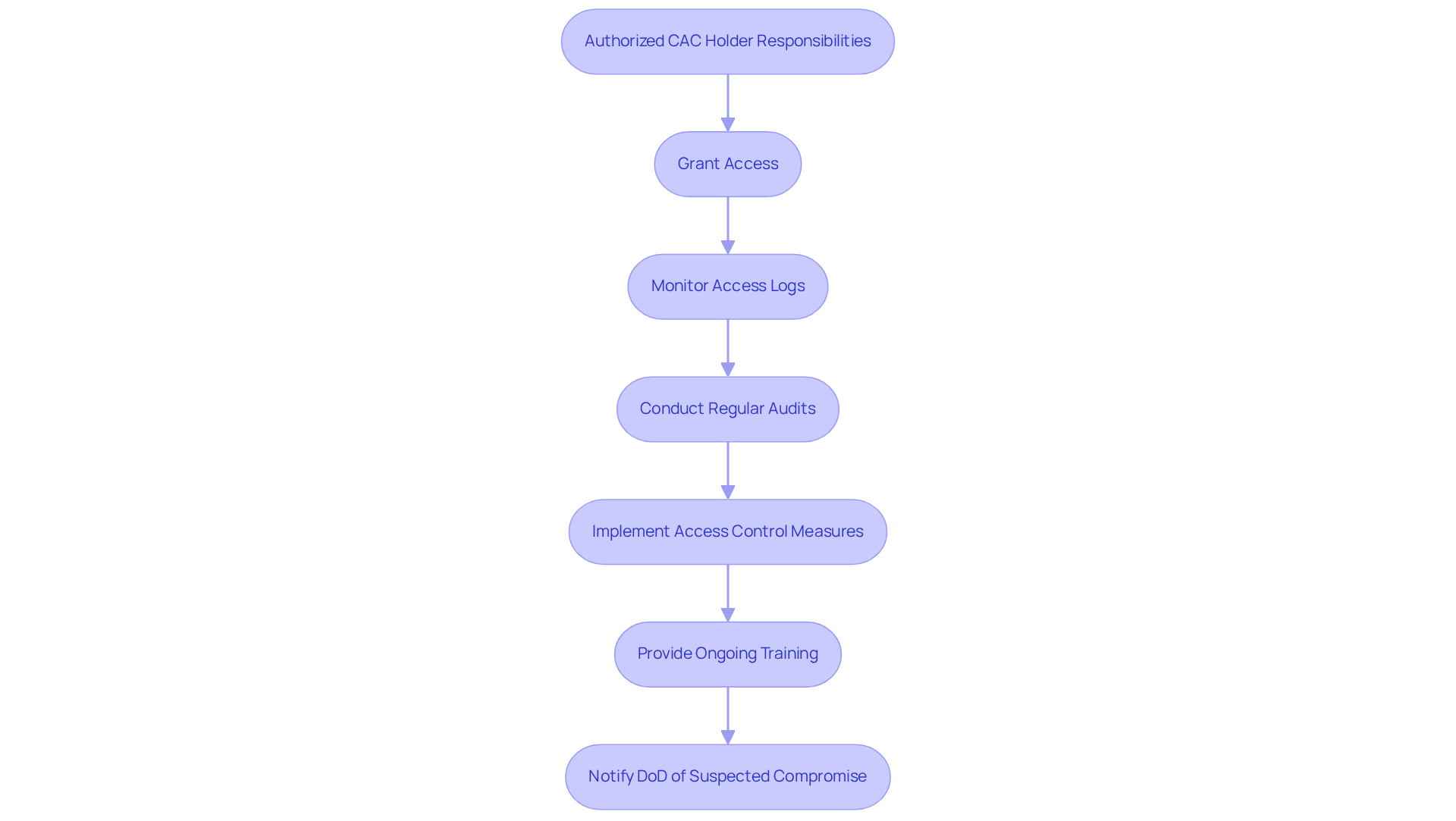
Authorized System Access Administrators: Overseeing CUI in IT Systems
Authorized system access administrators are pivotal in securing IT systems that store or process Controlled Unclassified Information (CUI). Their responsibilities include:
- Implementing stringent access controls
- Monitoring system activities
- Ensuring compliance with cybersecurity policies
This role requires a thorough understanding of both technical specifications and regulatory frameworks to effectively safeguard CUI. To achieve CMMC adherence, it is imperative for administrators to master and successfully pass assessments. Continuous education and updates on security protocols are vital for maintaining a robust IT environment, empowering administrators to respond adeptly to evolving threats and compliance demands.
By cultivating a culture of security awareness and proactive management, these administrators significantly bolster the organization's capacity to protect sensitive information. As a practical recommendation, administrators should routinely review and update their security protocols to align with the latest CMMC standards.
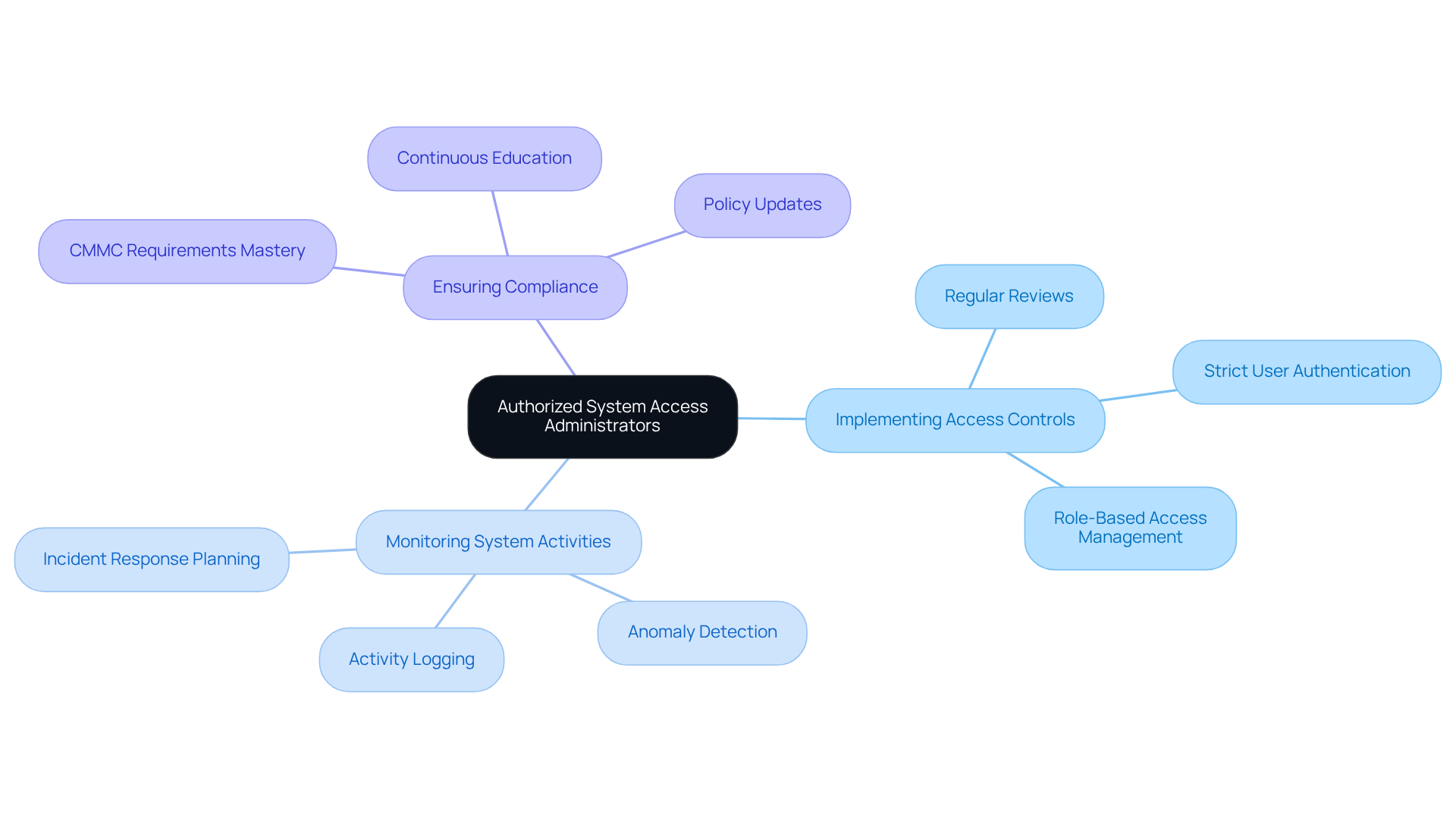
Training and Awareness: Ensuring Correct CUI Marking Application
Training and awareness initiatives are essential for ensuring that employees know who is responsible for applying . Organizations must conduct regular instructional sessions that emphasize the significance of CUI and clarify who is responsible for applying CUI markings and dissemination instructions, along with detailing the potential repercussions of non-compliance. According to the Department of Defense, effective preparation must identify who is responsible for applying CUI markings and dissemination instructions, thereby reinforcing the critical role each employee plays in safeguarding sensitive information. The mandatory course for DOD personnel with access to CUI is the 'DOD Mandatory Controlled Unclassified Information (CUI) Course,' which underscores the formal educational requirements established by the Department of Defense.
Implementing best practices in CUI marking instruction can significantly enhance accuracy and compliance. For instance, educational programs should include practical exercises that allow employees to engage with real-world situations, thereby reinforcing their understanding of marking protocols. Additionally, integrating feedback systems can assist organizations in evaluating the effectiveness of their development programs and making necessary adjustments. A survey indicated that organizations with robust development programs experience a notable increase in marking accuracy, which in turn reduces the risk of mishandling CUI.
Insights from development experts highlight the transformative impact of well-structured programs. Harvey S. Firestone observed that "the growth and development of people is the highest calling of leadership," emphasizing the importance of investing in employee education. Furthermore, statistics reveal that 94% of employees would remain longer with a company that invests in their learning and development, underscoring the long-term benefits of education on employee retention and compliance.
To foster a culture of awareness, organizations should also promote continuous education regarding CUI. This can include refresher courses and updates on any changes to marking requirements, as well as ensuring that records of instruction are maintained for audit purposes. By prioritizing training and awareness, organizations can significantly mitigate the risks associated with CUI mishandling, ensuring compliance and effectively safeguarding sensitive information.
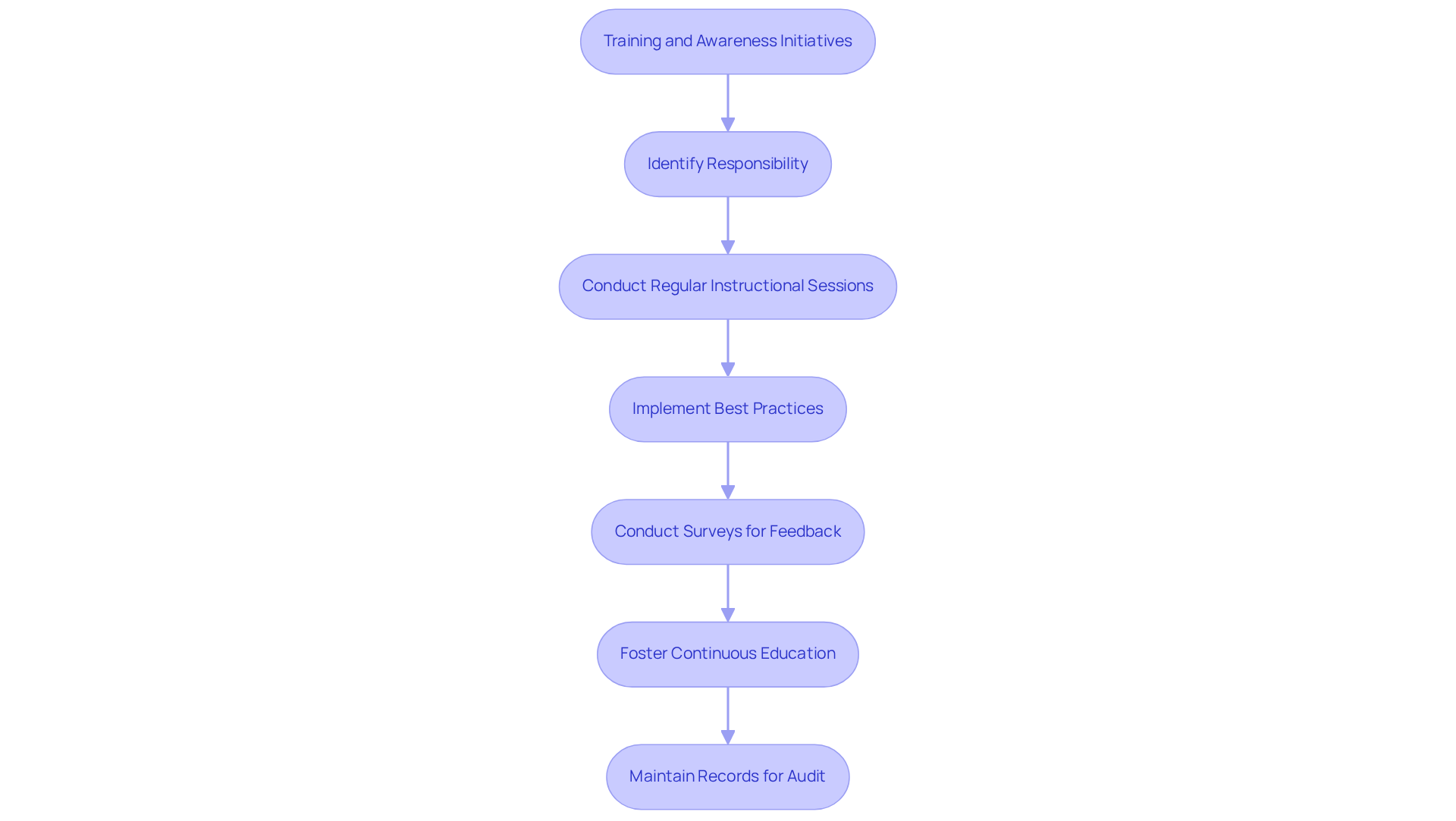
Compliance Officers: Monitoring CUI Policy Adherence
Compliance officers play a crucial role in supervising adherence to Controlled Unclassified Information (CUI) policies, specifically regarding who is responsible for applying CUI markings and dissemination instructions within organizations. Their responsibilities encompass:
- Conducting regular audits
- Scrutinizing adherence reports
- Ensuring that all employees comply with established guidelines
This proactive approach is essential; organizations that embrace continuous adherence practices report significantly higher success rates in audits. Notably, 91% of companies plan to implement within the next five years, underscoring a growing trend towards this practice. Furthermore, firms with consistent audit timelines experience a 30% increase in adherence success compared to those that conduct audits infrequently.
By identifying potential adherence gaps and executing corrective actions, compliance officers not only uphold the integrity of CUI handling practices but also cultivate a culture of accountability and continuous improvement. Engaging with CMMC accredited entities early in the adherence process can provide invaluable insights, as organizations should connect with these entities to gain guidance on assessment expectations. As entities face increasing regulatory oversight, the role of compliance officers, who are responsible for applying CUI markings and dissemination instructions, becomes even more critical in navigating the complexities of CUI adherence and ensuring that robust cybersecurity protocols are established.
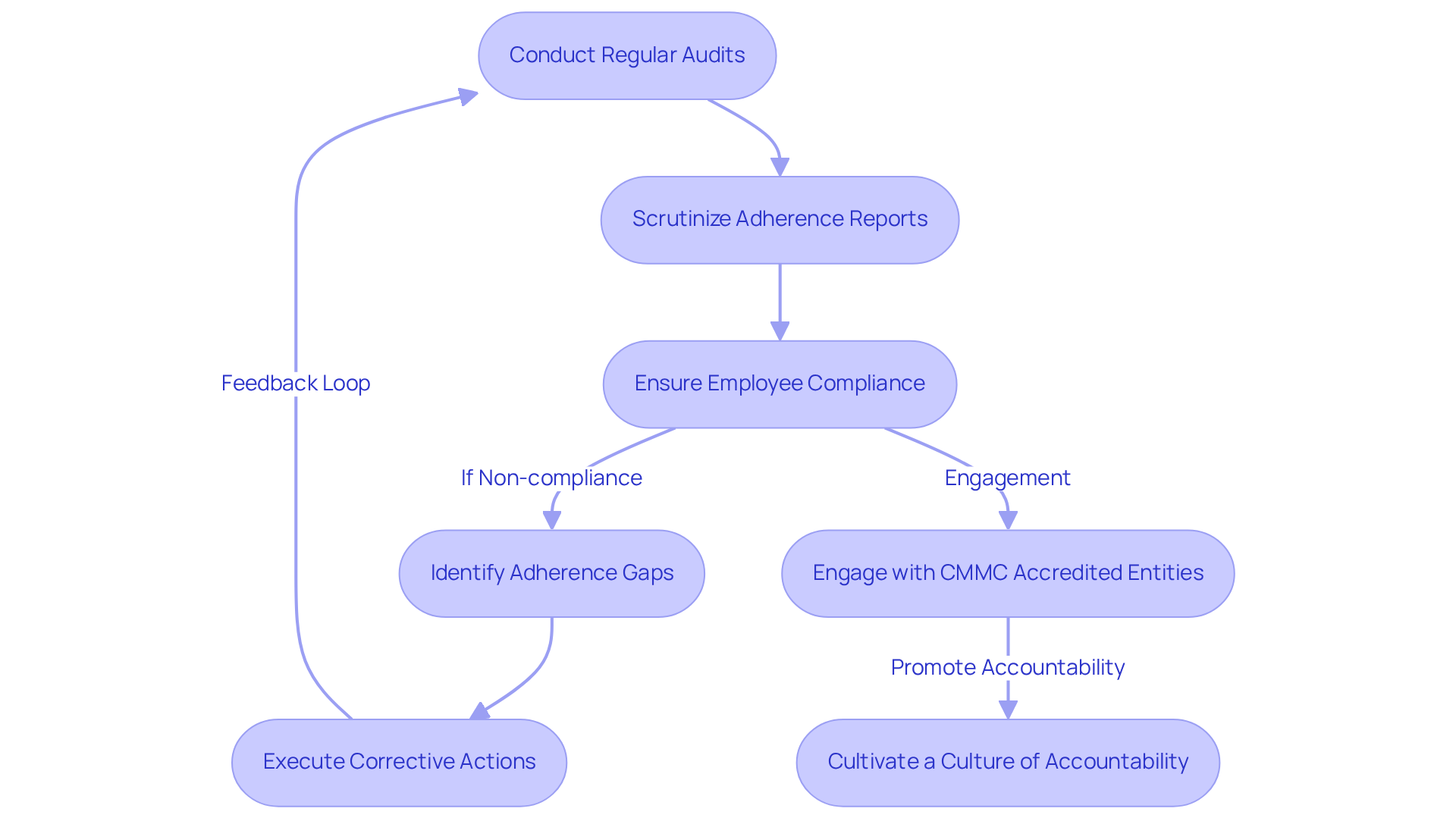
Legal Advisors: Guiding CUI Regulatory Compliance
Legal advisors play a pivotal role in navigating the intricate regulatory landscape surrounding Controlled Unclassified Information (CUI). Their expertise is essential for and ensuring that entities fully understand their legal responsibilities. By actively monitoring updates in CUI regulations, legal advisors enable organizations to adapt to changes, thereby mitigating potential legal risks associated with CUI handling. This proactive approach not only enhances compliance success but also fosters a culture of responsibility within firms.
Moreover, legal advisors are instrumental in drafting comprehensive CUI policies that align with current regulations, ensuring that all necessary safeguards are effectively implemented. As entities face increasing scrutiny regarding their management of sensitive information, the insights provided by legal advisors become indispensable for achieving and maintaining compliance.
It is crucial for entities to remain vigilant, as this platform may contain links to external websites. Verifying the reliability of these resources is important, given that we have no control over their content or availability.
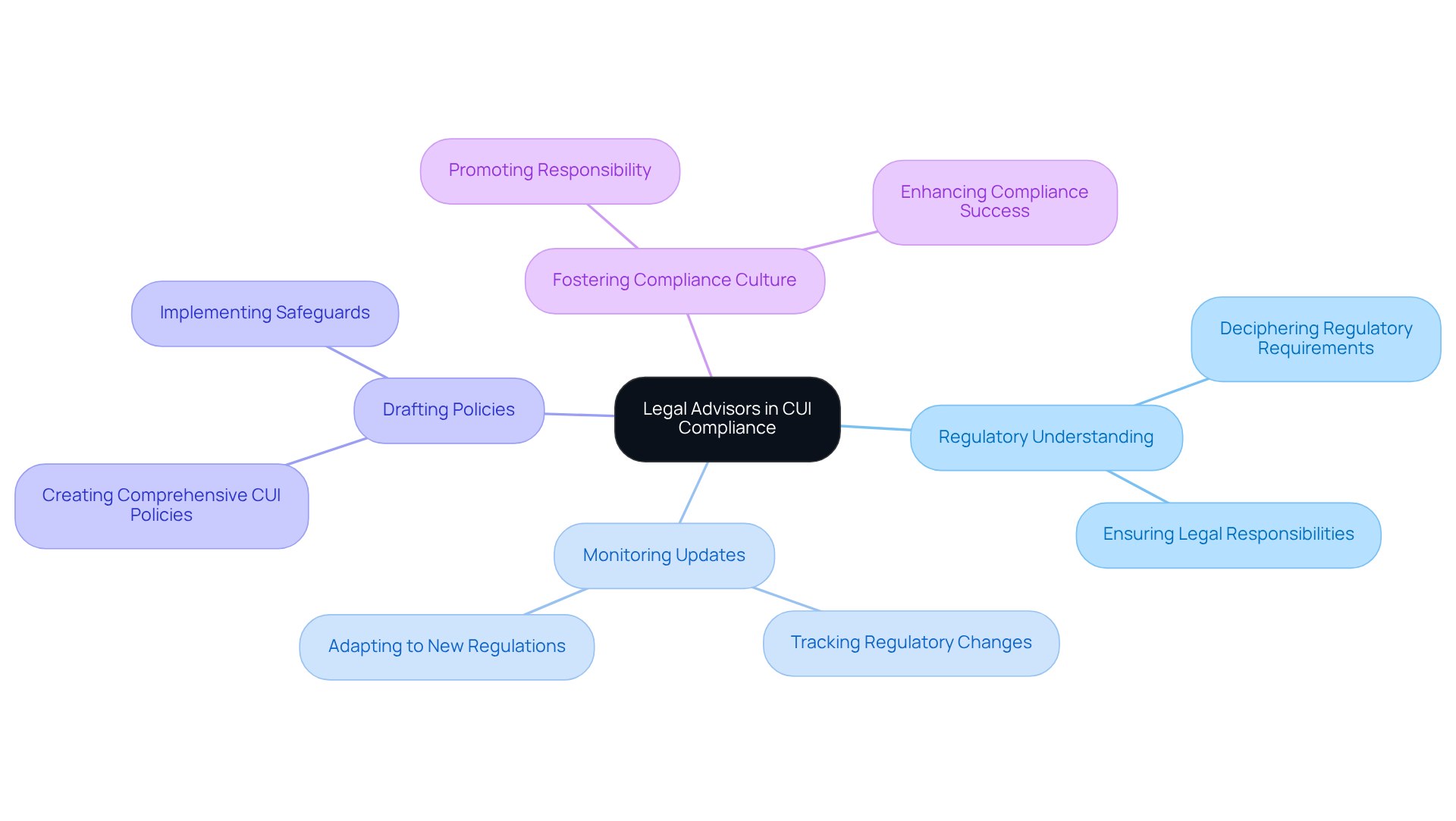
External Auditors: Assessing CUI Compliance Standards
External auditors serve a pivotal function in evaluating a company's compliance with Controlled Unclassified Information (CUI) standards. Their assessments involve comprehensive examinations of policies, procedures, and practices to ensure adherence to regulatory requirements. By conducting independent evaluations, these auditors not only identify areas for improvement but also reinforce the organization's commitment to maintaining CUI compliance.
This independent oversight is essential for entities seeking to , as it provides objective insights that can lead to substantial enhancements in CUI management practices. Moreover, the results from external audits often act as a catalyst for organizations to refine their CUI policies, ensuring alignment with best practices and regulatory expectations.
Are you ready to leverage these insights for your organization's compliance journey?
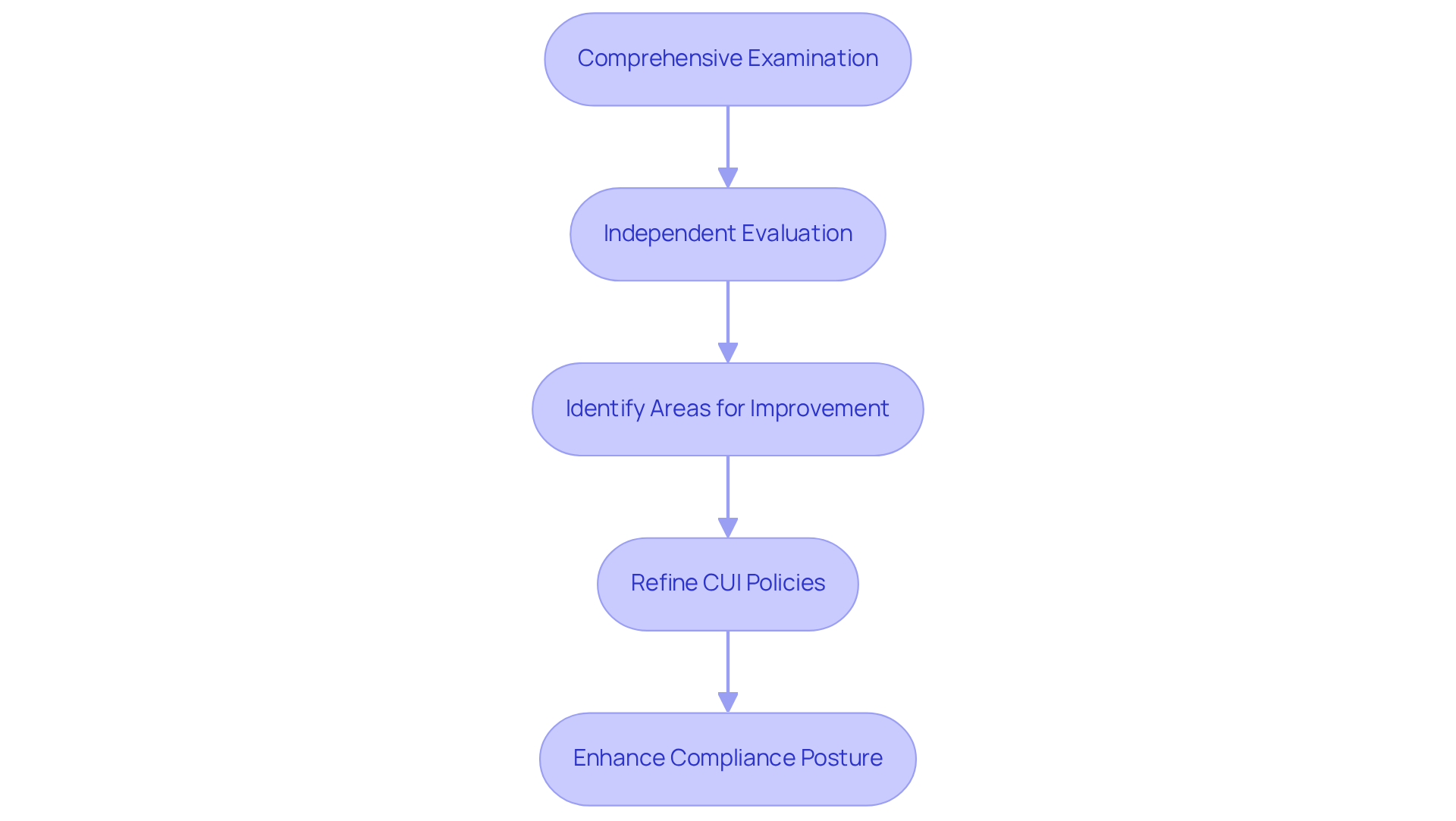
Conclusion
The effective management of Controlled Unclassified Information (CUI) is paramount in ensuring compliance with the Cybersecurity Maturity Model Certification (CMMC) and safeguarding sensitive data. This article emphasizes the critical roles that various stakeholders play in applying CUI markings and instructions, highlighting that a collaborative approach is essential for maintaining compliance and enhancing organizational security.
Key responsibilities span across:
- Organizational leadership
- Designated employees
- Document creators
- Compliance officers
All of whom contribute to a culture of adherence and accountability. Moreover, training and awareness initiatives further solidify the understanding and application of CUI protocols. Legal advisors and external auditors provide the necessary guidance and oversight to navigate the complex regulatory landscape. Each role is interconnected, forming a robust framework that not only meets regulatory requirements but also strengthens the overall cybersecurity posture of organizations.
In conclusion, organizations must recognize the significance of these roles and invest in comprehensive training and compliance strategies to effectively manage CUI. By fostering a culture of awareness and responsibility, companies can navigate the complexities of CUI regulations, safeguard sensitive information, and maintain eligibility for federal contracts. Embracing these best practices ensures a proactive stance against potential risks, ultimately enhancing the integrity and security of national defense operations.
Frequently Asked Questions
What is the purpose of the CMMC Info Hub?
The CMMC Info Hub serves as a resource for organizations aiming to meet the Cybersecurity Maturity Model Certification (CMMC) requirements, particularly regarding Controlled Unclassified Information (CUI). It provides various resources, including articles, guides, and strategies to address CUI regulations.
Why is compliance with CUI regulations important?
Compliance with CUI regulations is critical as the Department of Defense (DoD) increases its focus on cybersecurity standards. Adhering to these regulations helps organizations secure defense contracts and avoid penalties.
What strategies can organizations implement for CUI compliance?
Effective strategies include thorough documentation of CUI data flows and network segmentation. These practices simplify compliance, reduce audit complexity, and lower costs.
What role does organizational leadership play in CUI compliance?
Organizational leadership is responsible for defining and implementing CUI compliance policies, ensuring they align with DoD requirements, and communicating them effectively throughout the organization to foster a culture of compliance.
Who are designated employees in the context of CUI compliance?
Designated employees are responsible for applying CUI markings and dissemination instructions on documents and materials, ensuring that sensitive information is managed correctly and preventing unauthorized access.
What are the requirements for marking documents containing CUI?
Every document containing CUI must include a CUI header and a designation indicator to facilitate proper recognition of sensitive material.
How can organizations visualize CUI data flows?
Organizations can create data flow diagrams to visualize CUI data flows, which include communications between systems, personnel, third-party vendors, and customers.
What benefits do regular practice meetings provide for CUI compliance?
Regular practice meetings reinforce the importance of accurate marking and enhance adherence to federal regulations, contributing to a decrease in adherence failures and security incidents related to CUI mishandling.
What impact do training initiatives have on CUI management?
Effective training initiatives, including practical exercises and assessments, equip employees to manage CUI appropriately, thus strengthening the overall security posture of defense contractors.



